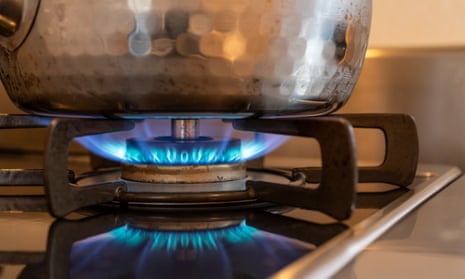US renters have growing worries over gas stoves – and few options
"Lack of choice over appliances is acutely felt by renters as new research reveals extent of indoor air pollution

New research has revealed the extent of indoor air pollution caused by gas stoves. Switching to alternatives like electric or induction stoves is the best way to reduce the health risk of burning fossil fuels in the kitchen – but that is rarely an option for renters, who typically can’t choose the type of appliances installed in their apartment.
People stuck with gas stoves in rentals are grappling with the reality of living with an appliance that may be leaking dangerous pollutants like methane and benzene even when it’s turned off. The lack of choice over appliances is acutely felt in low-income housing.
“I remember my elementary school was heated throughout the winter by burning coal or heating oil,” said Russell Taylor, who has lived in New York City public housing since 1972. After school, Taylor said, “I went home and was exposed to gas burning from my stove.”
Taylor says that growing up, his family used the stove for more than cooking. “Because of inadequate heating and freezing temperatures during the winter, we used the stove to stay warm in our apartment,” Taylor said, adding that they would turn the stove up on high, open the oven door, and lay socks and T-shirts on the stove racks, unaware of the nitrogen oxides – a pollutant linked with asthma and respiratory issues – they were exposed to daily.
Taylor is a member of We Act for Environmental Justice, which advocates for people of color and low-income communities nationwide. Last October, the organization sent a petition to the US Department of Housing and Urban Development along with other advocacy groups, calling on the agency to tackle indoor air pollution through electrification. The petition also calls to address cumulative indoor air pollutants like mold and mildew, pests, lead paint and other hazards found in public housing.
“This is a long-overdue conversation,” said Annie Carforo, a climate justice campaigns coordinator at We Act, regarding the latest nationwide debate on gas stoves. “Because New York City’s housing stock is so old and dense, there is very little option, and folks take the housing that they can get.”
Natural gas is used to fuel multiple things in US homes, but relatively little of it isused for cooking; the vast majority of natural gas consumption in homes – roughly 96% – comes from heating. Some renters are taking the health risks seriously by measuring their daily exposure to pollution emitted from gas stoves. In Washington DC, a group of renters from the Washington Interfaith Network have tested the levels of indoor air quality from their stoves.
Barbara Briggs, who lives in the Woodley Park neighborhood, was shocked to find nitrogen dioxide (NO2) levels of 220 parts per billion (ppb) in her kitchen, more than double the level identified as safe by the Environmental Protection Agency for one hour of exposure. Briggs uses an induction stovetop as her burner of choice. “I bought an electric kettle so I don’t have to use my gas stove to make coffee or boil water,” Briggs said, adding that on the rare occasion that she does use the stove, she opens the kitchen window.
Richard Vilmenay has been living in a rent-controlled Dupont Circle apartment for nearly 10 years. Tests showed NO2 levels in his apartment were even higher, coming in at 386ppb.
“I didn’t think it would be that high,” Vilmenay said. He added that ever since then, he’s been using the gas stove a lot less in favor of his microwave and looked into installing an induction stove. Vilmenay, who lives with his two-year-old daughter, is considering bringing up the possibility of switching out of a gas stove with his building’s management company.
“I’m thinking about her health and eliminating any potential harmful effects to her development,” Vilmenay said. A recent study found that roughly 12.7% of childhood asthma in the US is due to exposure in homes with gas stoves. “Moving is a real possibility,” Vilmenay said.
At the end of 2021, New York City passed a law banning the use of gas in new construction, and starting in 2024, new buildings under seven stories will be fully electric. But for people living in existing housing, there aren’t many options to reduce fossil fuel use in their homes. There is currently no legislation or housing policy that requires landlords to switch out gas stoves, but Carforo says that enacting Good Cause Eviction protection is a way to equalize the dynamic between the landlord and the renter.
“It gives renters more power to demand better housing conditions, and push their landlords to apply for government programs that could help them electrify their stoves,” Carforo said about the legislation, which bars landlords from evicting tenants without good cause, as well as limit the amount that rent can increase year over year. Housing organizers have been pushing for good cause eviction measures in numerous cities, and versions of the good cause protection passed in New York cities like Kingston, Poughkeepsie, Beacon, Hudson and Newburgh. The state capital, Albany, was the first to pass the eviction statute in July 2021, but it was overturned by a judge in June 2022, ruling that it violated state law. The city appealed the decision, arguing their case in the appellate court earlier this month.
In 2021 We Act launched a pilot program that replaced gas stoves with electric induction stoves and ovens in 20 public housing apartments in the Bronx and Buffalo, New York. Preliminary findings show that by removing the gas stoves, the levels of NO2 in apartments dropped by roughly 35%."
No comments:
Post a Comment